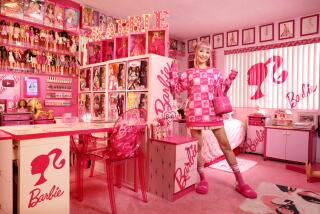Bubbleheads of Summer
- Share via
It’s the season of languid afternoons, a time of year when adults cast off responsibility to play children’s games. Bubbles appear in the air--deliciously iridescent and impermanent--perfect spheres that disappear with a tiny pop.
“It’s like watching clouds going across the sky,” said Reyne Rice, a publicist for the market research company National Purchase Diary, which tracks the sales of bubbles and bubble toys. “In the summer, you’re lazy. You can do things like that.”
The infinitesimally thin concoctions of soapy water and breath have inspired dreamy wonder, nostalgia, romantic notions and songs (think Lawrence Welk and “I’m Forever Blowing Bubbles”).
But there’s another side to the bubble, a competitive side driven by the quest for novelty in a pastime that dates back centuries. On the cutting edge of the bubble biz is a quest for better soap solutions, more innovative wands, edible bubbles and the next new thing in hot-selling, battery-powered blowers. The business end of the bubble is serious. Very serious.
Exhibit A: the decades-long competition between Chicago’s Strombecker Corp./Tootsietoy Products and Imperial Toy Corp. in Los Angeles, widely considered the world’s top manufacturers of bubble solution and bubble toys. Both claim to be the leader of the $66-million-a-year industry, and each insists that the secret to its success is in the solution--which is 99% water.
For his part, Dan Shure, president of Strombecker Corp./Tootsietoy Products, claims that his company’s Mr. Bubbles solution creates larger, longer-lasting and more plentiful bubbles with more vibrant “rainbow effects.”
David Kort, Imperial’s vice president of marketing and licensing, scoffs at Tootsietoy’s claim and credits his company with popularizing the industry’s best-sellers. “I think it’s really a non-issue,” he says of Shure’s claims. “We wouldn’t be selling tens of millions of bottles of bubbles a year, several times over, if [Imperial’s Miracle Bubbles] solution didn’t work.”
*
This year, the top-selling bubble item in America is Spin Master Toys’ Catch-a-Bubble, a toy that uses a thick, syrupy solution to produce sticky bubbles that last for days. (Does a bubble that lasts for days, not moments, lose its essential bubble nature? That’s a question for philosophers, not bubble salesmen.)
Alerted to this ranking, Kort grows slightly perturbed. “We had that same process five years ago,” he says. “We have items just like that. It’s not a true bubble item.”
Strombecker Corp./Tootsietoy Products once earned the top spot in U.S. bubble-toy sales with its battery-powered bubble gun. “You just keep pulling the trigger and it just spews bubbles all over the place,” said publicist Rice. “It’s a really, really fun toy. It just blew off the shelves. Very hot item.”
Kort’s response? “It’s not the first of its type.”
Today, the two companies compete fiercely for the tiny bit of retail shelf space allotted to bubble toys. They even disagree on how bubbles were popularized.
According to Shure, it was in the 1920s, when a Chicago pharmacist named Sid Belmont packaged soap solutions in glass bottles and started selling them to children. He founded a chemical company that in 1979 was acquired by Strombecker Corp./Tootsietoy Products.
But the history is recounted differently by Imperial’s founder and president Fred Kort, David’s father. As he tells it, a Charlotte, N.C., man named Joe Scott (brother to actor Randolph Scott) founded a bubble manufacturing company in 1946, bringing bubbles to the masses. Kort’s first bubble job was at the California branch of Scott’s company.
An interesting footnote to Fred Kort’s history: His oldest sons, Steven and Jordan Kort, left Imperial Toy Corp. in 1999 to start their own toy company in Northridge called What Kids Want. Now, the brothers are marketing their own brand of bubbles, a dry chemical that comes attached to a wand and, when dipped in water, produces a “cleaner” bubble called a “Wubble.” Steven says he isn’t really competing with his father and brother, because “we have the most innovative bubbles in probably 15 years.”
*
“There’s a little art in this, as crazy as it sounds,” says David Kort. He’s standing in the “bubble area” of the company’s vast toy showroom, a child’s dream where thousands of toys line lavender walls. The boyish-faced man has rolled up his sleeves and is earnestly blowing bubbles from a kazoo.
When the toy fails him, he picks up a large purple paddle that creates “bubbles within bubbles, if you will,” says Kort. Soon the office table is strewn with bubble toys and wet with puddles of bubble solution.
*
Then, it’s on to the battery-powered bubble machines. As Chief Financial Officer Peter Tiger takes the Bubble Torch, Kort handles the Triple Bubble Blaster, which lights up and shoots bubbles in three directions. Huge clouds of bubbles surround the two men. “We’ll just create a bubble storm here,” Kort says, with a childlike giggle. Then, he explains Imperial’s goal: to give children “something so high-tech to keep them interested.”
Hence, the bubble toys resembling a video game controller, cell phone and video camera. Kort explains, “We’re trying to emulate real-life experience for children.”
And, perhaps, put a few more pretty bubbles in the air.
More to Read
The biggest entertainment stories
Get our big stories about Hollywood, film, television, music, arts, culture and more right in your inbox as soon as they publish.
You may occasionally receive promotional content from the Los Angeles Times.










